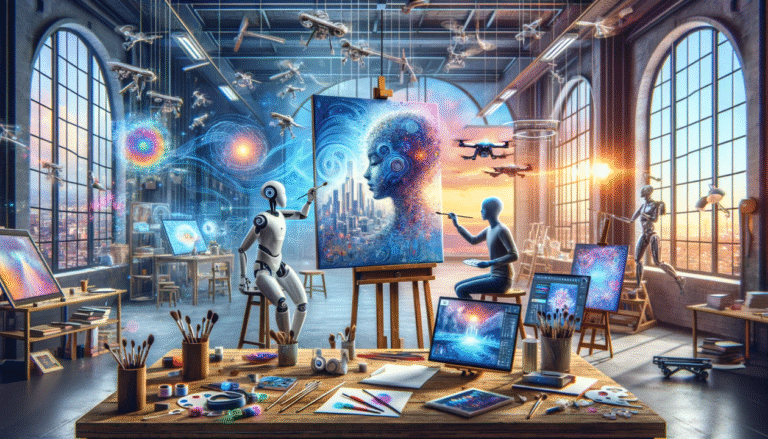Introduction
Artificial Intelligence (AI) is rapidly transforming creative workflows, with AI image generation emerging as one of the most disruptive technologies across industries. From advertising to gaming, publishing to e-commerce, the ability to instantly produce high-quality visuals using text-to-image AI is changing how professionals create, edit, and deliver content.
With the evolution of web-based AI art tools, creatives now have access to powerful, fast, and flexible platforms that require no advanced design skills. This shift is unlocking new opportunities and streamlining workflows like never before.
The Rise of Text-to-Image AI in Creative Industries
At the core of this revolution is text-to-image AI, which turns simple prompts into detailed visual art. Whether it’s for product mockups, social media graphics, or conceptual designs, this technology allows creators to bring their ideas to life instantly—no need for stock images or long hours behind design software.
For instance:
- Marketing teams use AI-generated visuals to test ad creatives quickly.
- Authors and publishers generate custom cover art tailored to specific themes.
- Game developers experiment with environments and character concepts in seconds.
AI-Driven Image Refinement: Perfecting Every Pixel
Once an image is created, tools like AI-driven image refinement ensure the final result meets professional standards. These features allow users to fine-tune colors, contrast, texture, and other visual elements without advanced editing skills.
In high-demand fields like fashion, architecture, or automotive design, such refinement features help professionals polish visuals to meet brand standards or client expectations.
Inpainting Tools: The Magic of Intelligent Editing
One of the standout features in AI-powered design tools is the inpainting tool. This allows users to remove, replace, or regenerate specific parts of an image without affecting the entire composition.
For example:
- Editors can erase unwanted objects.
- Artists can reimagine portions of an artwork without starting from scratch.
- Brands can localize visual elements for different markets.
This capability enhances productivity and encourages experimentation—key drivers in fast-moving creative sectors.
Unlimited Image Creation: Removing Creative Boundaries
Perhaps the most exciting aspect of modern AI image generation platforms is unlimited image creation. Unlike traditional design models that require manual input for every iteration, AI enables users to produce countless visual variations instantly.
This is a game-changer for:
- Content creators who need fresh visuals daily.
- Agencies managing multiple clients with different design styles.
- Startups operating on tight budgets but requiring high-quality imagery.
Web-Based AI Art Tools: Accessible and Scalable
Gone are the days of relying solely on desktop-based software. Web-based AI art tools offer full creative power directly in the browser. This flexibility is critical for remote teams, freelance artists, and businesses looking for quick turnaround times.
These tools don’t just simplify access—they also enable collaboration, reduce the need for powerful hardware, and minimize storage concerns.
Style Customization and Image Upscaling: Tailored Creativity
Another key strength of today’s AI tools is style customization. Whether it’s making artwork resemble an oil painting, cyberpunk aesthetic, or vintage sketch, style-based filters and controls let users match visuals to their brand or personal taste.
Additionally, image upscaling AI ensures that the final image retains clarity—even when printed on large formats or displayed on high-resolution screens.
These features have practical applications in:
- Print media
- Online storefronts
- Art and design portfolios
Fast AI Art Workflow: Saving Time, Increasing Output
In creative industries, speed is often a competitive advantage. Fast AI art workflow tools dramatically cut the time it takes to brainstorm, design, revise, and deliver projects. From idea to final asset, what used to take days now takes minutes.
This is especially valuable for:
- Social media managers racing to stay relevant
- Video editors needing quick backgrounds or overlays
- Teams under pressure to meet tight client deadlines
Privacy-Focused Art Generation: Security for Professionals
With increasing concerns over data privacy and copyright, privacy-focused art generation tools are becoming more important. Many platforms now ensure that user data, prompts, and outputs are not stored, reused, or trained into public models.
This is essential for:
- Corporate teams working on confidential campaigns
- Artists protecting their creative inputs
- Businesses needing proprietary designs
Conclusion
From automating tedious tasks to sparking entirely new creative possibilities, AI image generation is reshaping how industries approach visual content. The combination of text-to-image AI, inpainting tools, style customization, and image upscaling AI has made visual design faster, more flexible, and more accessible than ever before.
As tools continue to evolve and prioritize user privacy, the future of web-based AI art tools looks promising—not just for artists, but for anyone seeking a smarter way to create.

